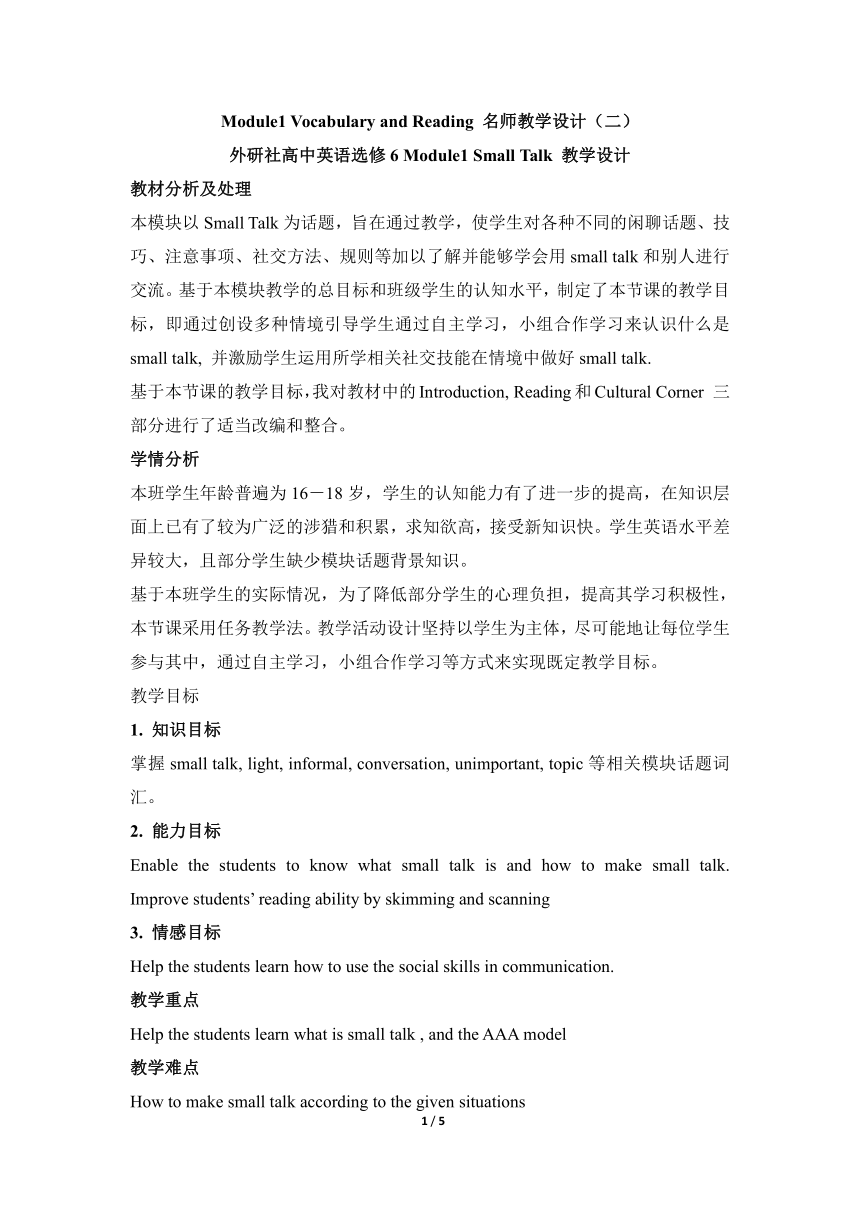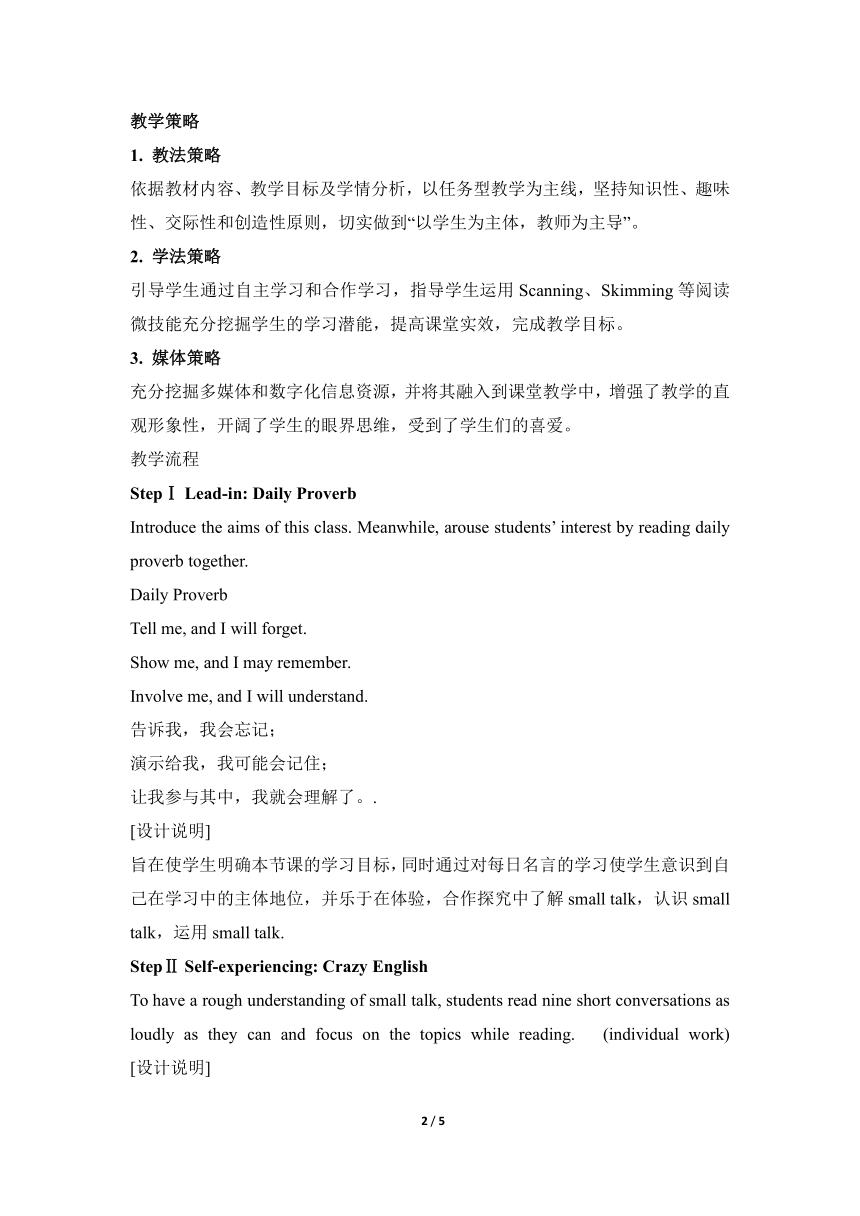外研版 选修6 Module1 Small Talk Vocabulary and Reading 名师教学设计(二)(文本式)
文档属性
| 名称 | 外研版 选修6 Module1 Small Talk Vocabulary and Reading 名师教学设计(二)(文本式) |  | |
| 格式 | doc | ||
| 文件大小 | 210.0KB | ||
| 资源类型 | 教案 | ||
| 版本资源 | 外研版 | ||
| 科目 | 英语 | ||
| 更新时间 | 2023-02-15 10:39:59 | ||
图片预览


文档简介
Module1 Vocabulary and Reading 名师教学设计(二)
外研社高中英语选修6 Module1 Small Talk 教学设计
教材分析及处理
本模块以Small Talk为话题,旨在通过教学,使学生对各种不同的闲聊话题、技巧、注意事项、社交方法、规则等加以了解并能够学会用small talk和别人进行交流。基于本模块教学的总目标和班级学生的认知水平,制定了本节课的教学目标,即通过创设多种情境引导学生通过自主学习,小组合作学习来认识什么是small talk, 并激励学生运用所学相关社交技能在情境中做好small talk.
基于本节课的教学目标,我对教材中的Introduction, Reading和Cultural Corner 三部分进行了适当改编和整合。
学情分析
本班学生年龄普遍为16-18岁,学生的认知能力有了进一步的提高,在知识层面上已有了较为广泛的涉猎和积累,求知欲高,接受新知识快。学生英语水平差异较大,且部分学生缺少模块话题背景知识。
基于本班学生的实际情况,为了降低部分学生的心理负担,提高其学习积极性,本节课采用任务教学法。教学活动设计坚持以学生为主体,尽可能地让每位学生参与其中,通过自主学习,小组合作学习等方式来实现既定教学目标。
教学目标
1. 知识目标
掌握small talk, light, informal, conversation, unimportant, topic等相关模块话题词汇。
2. 能力目标
Enable the students to know what small talk is and how to make small talk. Improve students’ reading ability by skimming and scanning
3. 情感目标
Help the students learn how to use the social skills in communication.
教学重点
Help the students learn what is small talk , and the AAA model
教学难点
How to make small talk according to the given situations
教学策略
1. 教法策略
依据教材内容、教学目标及学情分析,以任务型教学为主线,坚持知识性、趣味 性、交际性和创造性原则,切实做到“以学生为主体,教师为主导”。
2. 学法策略
引导学生通过自主学习和合作学习,指导学生运用Scanning、Skimming等阅读微技能充分挖掘学生的学习潜能,提高课堂实效,完成教学目标。
3. 媒体策略
充分挖掘多媒体和数字化信息资源,并将其融入到课堂教学中,增强了教学的直观形象性,开阔了学生的眼界思维,受到了学生们的喜爱。
教学流程
StepⅠ Lead-in: Daily Proverb
Introduce the aims of this class. Meanwhile, arouse students’ interest by reading daily proverb together.
Daily Proverb
Tell me, and I will forget.
Show me, and I may remember.
Involve me, and I will understand.
告诉我,我会忘记;
演示给我,我可能会记住;
让我参与其中,我就会理解了。.
[设计说明]
旨在使学生明确本节课的学习目标,同时通过对每日名言的学习使学生意识到自己在学习中的主体地位,并乐于在体验,合作探究中了解small talk,认识small talk,运用small talk.
StepⅡ Self-experiencing: Crazy English
To have a rough understanding of small talk, students read nine short conversations as loudly as they can and focus on the topics while reading. (individual work) [设计说明]
疯狂阅读这一环节旨在使学生在真实的语境中发现目标语言small talk,并通过体验对small talk形成了初步的感性认识,从而激发了学生进一步探究small talk的热情,也为突破本节课的重点做好了铺垫。
Step Ⅲ Co-operation exploration: What is small talk
Task 1:Role-Play(pair work)& Discussion (group work)
1)Where does the conversation take place
2)What’s the topic they talk about
3)Are the two speakers friends or strangers
4) What’s the purpose of the speakers
5) Is the topic important or not important
6)Is the conversation serious or friendly
Task 2:Discussion:
Which of the given topics would you like to talk about with your friends or strangers why
[设计说明]
为深化认识,突破本节课的重点---让学生明白什么是Small Talk,我鼓励学生以Role-Play的方式再次体验目标语言,并抛出上述六个探究问题,引导他们用自己的语言给small talk下定义。通过Task 2来引导学生关注不同文化背景下选择恰当话题的重要性。
Step Ⅳ Fast-Reading
Task 1: To obtain more information about social skills and how to make a small talk, students are advised to read the passages, How Good Are Your Social Skills and The AAA, by using Skimming to get some information related to structures or Scanning to gain some specific information.
Task 2: Practice: Put the conversation in order (group work)
To check whether the students have mastered the AAA model, the students are required to put the conversation in order.
[设计说明]
一方面旨在培养学生通过使用Skimming,浏览副标题,迅速掌握文章结构、脉络的能力,以及依据关键词,使用Scanning快速捕捉特定信息的能力。另一方面,通过阅读使学生获得更多关于如何和他人进行small talk的相关知识,为突破本节课的难点提供了理论基础。
Step Ⅴ Show Time
Task: make up a small talk according to one of the given situations or the new situation created by yourselves and then act it out. (group work)
[设计说明]
此部分旨在通过创设情境,让学生通过小组合作,主动地运用所学的目标语言去做事,在使用所学语言做事的过程中发展语言能力,以展示任务成果的方式来体现教学的成果。
Step VI Summary and Homework
Give students an opportunity to recall or sum up what they have learnt in this class. [设计说明]
师生合作对本节课小结,并布置拓展性作业。
1 / 5
外研社高中英语选修6 Module1 Small Talk 教学设计
教材分析及处理
本模块以Small Talk为话题,旨在通过教学,使学生对各种不同的闲聊话题、技巧、注意事项、社交方法、规则等加以了解并能够学会用small talk和别人进行交流。基于本模块教学的总目标和班级学生的认知水平,制定了本节课的教学目标,即通过创设多种情境引导学生通过自主学习,小组合作学习来认识什么是small talk, 并激励学生运用所学相关社交技能在情境中做好small talk.
基于本节课的教学目标,我对教材中的Introduction, Reading和Cultural Corner 三部分进行了适当改编和整合。
学情分析
本班学生年龄普遍为16-18岁,学生的认知能力有了进一步的提高,在知识层面上已有了较为广泛的涉猎和积累,求知欲高,接受新知识快。学生英语水平差异较大,且部分学生缺少模块话题背景知识。
基于本班学生的实际情况,为了降低部分学生的心理负担,提高其学习积极性,本节课采用任务教学法。教学活动设计坚持以学生为主体,尽可能地让每位学生参与其中,通过自主学习,小组合作学习等方式来实现既定教学目标。
教学目标
1. 知识目标
掌握small talk, light, informal, conversation, unimportant, topic等相关模块话题词汇。
2. 能力目标
Enable the students to know what small talk is and how to make small talk. Improve students’ reading ability by skimming and scanning
3. 情感目标
Help the students learn how to use the social skills in communication.
教学重点
Help the students learn what is small talk , and the AAA model
教学难点
How to make small talk according to the given situations
教学策略
1. 教法策略
依据教材内容、教学目标及学情分析,以任务型教学为主线,坚持知识性、趣味 性、交际性和创造性原则,切实做到“以学生为主体,教师为主导”。
2. 学法策略
引导学生通过自主学习和合作学习,指导学生运用Scanning、Skimming等阅读微技能充分挖掘学生的学习潜能,提高课堂实效,完成教学目标。
3. 媒体策略
充分挖掘多媒体和数字化信息资源,并将其融入到课堂教学中,增强了教学的直观形象性,开阔了学生的眼界思维,受到了学生们的喜爱。
教学流程
StepⅠ Lead-in: Daily Proverb
Introduce the aims of this class. Meanwhile, arouse students’ interest by reading daily proverb together.
Daily Proverb
Tell me, and I will forget.
Show me, and I may remember.
Involve me, and I will understand.
告诉我,我会忘记;
演示给我,我可能会记住;
让我参与其中,我就会理解了。.
[设计说明]
旨在使学生明确本节课的学习目标,同时通过对每日名言的学习使学生意识到自己在学习中的主体地位,并乐于在体验,合作探究中了解small talk,认识small talk,运用small talk.
StepⅡ Self-experiencing: Crazy English
To have a rough understanding of small talk, students read nine short conversations as loudly as they can and focus on the topics while reading. (individual work) [设计说明]
疯狂阅读这一环节旨在使学生在真实的语境中发现目标语言small talk,并通过体验对small talk形成了初步的感性认识,从而激发了学生进一步探究small talk的热情,也为突破本节课的重点做好了铺垫。
Step Ⅲ Co-operation exploration: What is small talk
Task 1:Role-Play(pair work)& Discussion (group work)
1)Where does the conversation take place
2)What’s the topic they talk about
3)Are the two speakers friends or strangers
4) What’s the purpose of the speakers
5) Is the topic important or not important
6)Is the conversation serious or friendly
Task 2:Discussion:
Which of the given topics would you like to talk about with your friends or strangers why
[设计说明]
为深化认识,突破本节课的重点---让学生明白什么是Small Talk,我鼓励学生以Role-Play的方式再次体验目标语言,并抛出上述六个探究问题,引导他们用自己的语言给small talk下定义。通过Task 2来引导学生关注不同文化背景下选择恰当话题的重要性。
Step Ⅳ Fast-Reading
Task 1: To obtain more information about social skills and how to make a small talk, students are advised to read the passages, How Good Are Your Social Skills and The AAA, by using Skimming to get some information related to structures or Scanning to gain some specific information.
Task 2: Practice: Put the conversation in order (group work)
To check whether the students have mastered the AAA model, the students are required to put the conversation in order.
[设计说明]
一方面旨在培养学生通过使用Skimming,浏览副标题,迅速掌握文章结构、脉络的能力,以及依据关键词,使用Scanning快速捕捉特定信息的能力。另一方面,通过阅读使学生获得更多关于如何和他人进行small talk的相关知识,为突破本节课的难点提供了理论基础。
Step Ⅴ Show Time
Task: make up a small talk according to one of the given situations or the new situation created by yourselves and then act it out. (group work)
[设计说明]
此部分旨在通过创设情境,让学生通过小组合作,主动地运用所学的目标语言去做事,在使用所学语言做事的过程中发展语言能力,以展示任务成果的方式来体现教学的成果。
Step VI Summary and Homework
Give students an opportunity to recall or sum up what they have learnt in this class. [设计说明]
师生合作对本节课小结,并布置拓展性作业。
1 / 5
